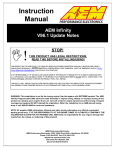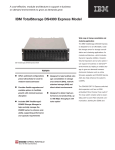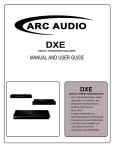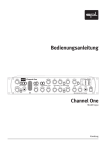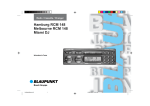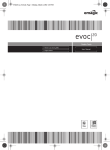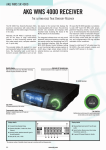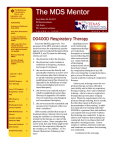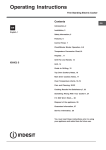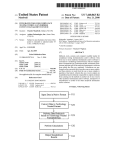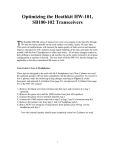Download Sound Performance Lab Parametric Equalizer User's Manual
Transcript
OPTIMIZER parametric equalizer Owner´s Manual Operation . Applications . Measurements . Specifications ©1994 SPL electronics GmbH OPTIMIZER Owner´s Manual: Operation, Applications, Measurements, Specifications Written by Paul White and Hermann Gier Manual version 1.1/94 The information in this document has been carefully checked and is assumed to be correct. However Sound Performance Laboratory (SPL electronics GmbH) reserves the right to modify the product described in this manual at any time. This document is the property of SPL electronics GmbH and may not be copied or reproduced in any manner, in part or full without the authorization of SPL electronics GmbH. Construction and circuit layout are subject to constant improvement and development. Changes will be made without notice. © 1994 SPL electronics GmbH All rights reserved CONTENTS INTRODUCTION 4 INSTALLATION 7 CONNECTORS 7 OPERATING LEVEL 8 POWER SUPPLY 8 REAR PANEL 9 INPUT & OUTPUT SPECIFICATIONS APPLICATIONS 9 10 MASTERING WITH THE OPTIMIZER 10 OPTIMIZER USED IN THE INSERTS 11 CONTROLS 12 FRONT PANEL 12 DUAL 13 ACTIVE 13 MASTER-EQ 13 PEAK 13 BOOST/CUT (+/-) 14 BANDWIDTH Q 15 FREQUENCY & FREQUENCY RANGE 16 OUTPUT 18 NOTCH 19 PARAMETRIC, HIGHPASS, BANDPASS, LOWPASS 20 PHASE MEASUREMENTS 22 NOISE MEASUREMENTS 24 COMMON MODE REJECTION 25 LIMITED WARRANTY 26 OPTIMIZER 3 INTRODUCTION Congratulations on purchasing the Optimizer, one of the most advanced and musical sounding parametric equalizer currently available. The Optimizer is a highly specialized and creative equali- The OPTIMIZER is designed for both corrective and creative applications, producing effects impossible to achieve using conventional EQ. Yet it remains very simple to operate. zer. In addition to familiar parametric functions, it features a range of modes that enable it to perform Band-pass, Highpass, Low-pass and Notch filtering. As you would expect from SPL - the company that developed the highly acclaimed Vitalizer psychoacoustic equalizer - the Optimizer is no ordinary equalizer. It excels in both corrective and creative applications and can produce many effects impossible to achieve using conventional parametric equalizers. Yet it remains very simple to operate. Rather working out a theoretically ideal filter response on paper, we have taken a more creative tack, experimenting directly with perceived sound across a wide range of frequencies. The design of the Optimizer has been based on proven psychoacoustic principles and particular regard has been taken to the way the human hearing system perceives sound, at all stages of development. Rather working out a theoretically ideal filter response on paper and trying to emulate it, we have taken a more creative tack, experimenting directly with perceived sound across a wide range of frequencies. The Optimizer provides a powerful, flexible and easyto-operate means of equalizing sound. The result of this creative work is an equalizer without equal, both technically and artistically. Not only does it provide a powerful, flexible and easy-to-operate means of equalizing sound, but it boasts a noise level approaching the theoretical minimum for advanced analogue circuit design and a dynamic range even better than 18-bit digital systems. The Optimizer produces a smooth and linear phase response giving unsurpassed musicality and sonic transparency The filter circuits are based on an advanced state-variable filter topography which employs the "proportional-Q" principle, active output stages for each filter-band and the new "roll-off"-function to produce a smooth and linear phase response giving the Optimizer unsurpassed musicality and sonic transparency. Rather than employing the standard "constant-Q" equalizer design commonly used in sound reinforcement and room equalizers, the Optimizer works on the proportional-Q prin- The advantage of proportional-Q is that it produces a more musical result and fine tuning of the filters is much easier. 4 ciple. The advantage of proportional-Q is that it produces a more musical result and fine tuning of the filters is much easier. The signal level is dependent of the bandwidth setting - eliminating the need for constant level readjustment when OPTIMIZER INTRODUCTION changing the filter settings. When broadening the bandwidth, the boost or cut will be reduced proportionally, so that the subjectively perceived loudness remains constant. The proportional-Q principle operates according to the way our hearing system perceives sound. With constant-Q equalizers there is often only a limited range of useable settings. Sometimes this is so narrow, you may wonder why the Q-control was not permanently fixed at the point it sounds really good. Above that position it often starts to sound harsh and peaky, and below with the broad bandwidth, the sound is colored so you need to constantly re-set the boost/cut control. Not so with proportional Q. The Q-control provides useable settings over the entire range - giving you more versatility to be creative. The Optimizer comprises four identical filter stages which can be configured for 4-band mono, dual 2-band mono or 2-band stereo operation. The Optimizer comprises four identical filter stages which can be configured for 4-band mono, dual 2-band mono or 2-band stereo operation. The front panel Dual switch selects between 4-band or dual 2-band operation. Both balanced XLR and unbalanced jacks are provided for signal connections to and from the Optimizer. In Mono mode, the filters are all connected in series, but the outputs from each pair of filters remain accessible, so you can get two differently filtered versions of the same signal which can Each filter covers the same enormous frequency range 10Hz to 23kHz. be useful when you are creating special effects. Each filter covers the frequency range 10Hz to 23kHz in four switched frequency ranges to give fine frequency control, regardless of which part of the audio spectrum is under process. Tuning the equalizer is very intuitive because the frequency control law has been designed to match the characteristics of the human hearing system. Being able to equalize starting at 10Hz with full boost/cut power gives a new dimension for mixing and producing of subwoofer-compatible soundtracks. The frequency response of the circuitry used in the audio signal path exceeds the limits of human hearing by a considerable margin, effectively eliminating undesirable phase shifts which, even when relatively small, can seriously Each filter has its own mode switch, so complex combinations of filter types can be used in the same signal path. impair the high frequency transparency of a less well-designed equalizer. Each filter has its own mode switch to select between High-pass, Low-pass, Band-pass and Parametric modes. In OPTIMIZER 5 INTRODUCTION addition each filter is equipped with a notch-filter. Selecting The depth of the Notch is in excess of 60dB the Notch mode overrides the mode switch selector. So complex combinations of filter types can be used in the same signal path. For example, a parametric filter could be combined with a High- and Low-pass and Notch filter. When working in Notch, Band-pass, High-Pass or LowPass modes, you have a choice of roll-off characteristics which greatly extends the tonal capabilities of the Optimizer. For example, in the Notch filter mode, you have control over frequency and bandwidth and also over the The Optimizer´s proportionalQ parametric filter design, combined with its switchable alternative filter modes, gives you the flexibility to emulate many different types of equalizer. steepness of the sides of the notch. The depth of the Notch is in excess of 60dB, providing an extremely high degree of rejection compared with conventional parametric filters. The subjective performance of certain classic equalizers is highly dependent on the roll-off characteristics of their filter circuitry. These equalizers sound excellent, but their circuit topography imposes a rather fixed character on them. By contrast, the Optimizer´s proportional-Q parametric filter design, combined with its switchable alternative filter The Boost/Cut control becomes the Gentle/Steep control in Notch, Band-Pass, HighPass or Low-Pass modes. Turning the control fully anti-clockwise produces a gentle roll-off while turning it fully clockwise produces a steep-sided response. modes, gives you the flexibility to emulate many different types of equalizer. In addition, you can set up further equalization types that even the best conventional equalizers cannot provide. To keep the control layout simple, the BoostCut control used in Parametric mode becomes the Gentle/Steep control in Notch, Band-Pass, High-Pass or Low-Pass modes. Turning the control fully anti-clockwise produces a gentle roll-off while turning it fully clockwise produces a steep-sided response. If the control is set in the center position, the input signal will cancel itself out completely, resulting in no output. Settings between the extremes and the center (null) position produce further useful variations in filter slope characteristic, though you may need to compensate for the level loss incurred by settings close to the center position, by turning up the Output level control. Selecting a steep filter characteristic produces a tightly The Optimizer has active output stages for each filter increasing phase stability dramatically. focused, punchy tonal characteristic while choosing a gentle slope produces a subtle change in tonality which has the effects of adding a sonic gloss to the programme material. We have invented a new all active output stage approach to mixing filters: Commonly filters in parametric or graphic equalizers mix passively resulting in increased phase distor- 6 OPTIMIZER tion as each filter is added to the signal path. The Optimizer overcomes this fault by using controllable all active output INSTALLATION stages resulting in a significantly improved phase response, even when all four filters are linked up. The Output control allows level adjustments to compensate for level changes due to dramatic boost or cut adjustments. The Optimizer is designed for standard 19” rack mounting and occupies 2U of rack space. Avoid mounting the unit CONNECTORS directly above power amplifiers or power supplies that radiate significant amounts of heat and always connect the mains earth to the unit. Fibre or plastic washers may be used to prevent the front panel becoming marked by the mounting The OPTIMIZER offers XLR connectors for balanced operation and quarter-inch jacks for unbalanced use. bolts. Care must be taken when rack mounting the unit to support the rear of the case, especially in mobile systems. The Optimizer has connectors for unbalanced as well balanced operation. The XLR inputs and outputs are electronically balanced on conventionally wired XLRs (pin 1 screen, pin 2 hot and How to unbalance balanced XLR connetors. pin 3 cold). Unbalanced inputs and outputs are also available on mono, quarter-inch jacks. OPERATING LEVEL The signal connected to the jacks will always be preferred. A connection set-up with XLR´s and jacks can remain connected. Unplugging the jacks will select the XLRs as primary inputs. The XLR inputs and outputs can be unbalanced by The operating level is switchable between High and Low (nominally 0dBu or 10dBv) connecting the pin 3 to the ground terminal (pin 1). For proper wiring see figure below. The operating level is switchable between High and Low (nominally 0dBu or -10dBv). Choose the High position for all pro-audio applications. Select the -10dB when the input sour- OPTIMIZER 7 INSTALLATION POWER SUPPLY ce is not driving Optimizer´s filters sufficiently with the proviso that the Peak LED on the front panel is not continually flashing. This will achieve equalization at a lower signal level and will result in a more intensely processed sound. Note: this level change also effects the signal when the filters are in bypass, so you will loose direct comparability as the listening level changes. A Ground Lift switch is provided to assist in the elimination of ground loop problems. Based around a toroidal transformer, the integral power supply is designed to minimize induced hum and noise due to the non existence of an air-gap. The primary voltage may be selected between 230V/50Hz and 115V/60Hz by means of a recessed slide switch on the rear panel. A Ground Lift switch is provided to assist in the elimination of ground loop induced hum in complex installations. If ground loop problems remain after activating the Ground Lift switch, do not disconnect the mains earth. Instead try disconnecting the signal screen at the end the cables that connect the outputs of the Optimizer to the patchbay. If such measures are necessary, balanced operation is recommended. When the Ground Lift switch is set off, the circuit ground is connected to the chassis ground. The mains fuse should be rated at 800mA. A detachable 3-wire, U-ground power cord is included in the packaging. 8 OPTIMIZER INSTALLATION REAR PANEL Input- & output specifications XLR - balanced: Inputs: Electronically balanced (differential) transformerless Impedance: = 20kOhms Nominal input level: +6dB Input level selector: HIGH (0dB) LOW(-10dB) Maximum input level: +22dBm Input peak: LED indicates potential peak 3dB before actual clipping. Outputs: Electronically balanced (differential) transformerless Impedance: < 75 Ohms Nominal output level: +6dB Minimum load ohms: 600 Ohms Connectors: Type: Neutrik NC 3 XLR Pin wiring: Pin 2 = high (+) and Pin 3 = low (-) Jacks - unbalanced: Inputs: unbalanced Impedance: = 20kOhms Nominal input level: 0dB Outputs: Impedance: Nominal output level: Minimum load ohms: unbalanced < 600 Ohms 0dB 600 Ohms Connectors: Type: 1/4" Jacks (6,25mm) Pin-Wiring: Tip = high (+) and Sleeve = GND GND-LIFTswitch: off = chassis ground on = ground lift Power selector: 115V / 60Hz 230V / 50Hz Fuse: OPTIMIZER 800mA fast 9 SET-UP & APPLCATIONS PARAMETRIC SET-UP: To use the Optimizer as a dualchannel, parametric equalizer proceed as follows: • Set all filters to PARAMETRIC • Set to DUAL mode and ensure MASTER BYPASS is out. • Use filter ACTIVE control to set up one equalizer sec- tion For precise location of the frequency you want, set the Boost/Cut control fully clockwise to provide maximum boost. at a time. • Select appropriate frequency range for each filter. • Set Q initially to midway point. SETTING UP PROCEDURE: When trying to locate the precise frequency range requiring adjustment, set the Boost/Cut (+/-) control fully clockwise to provide maximum boost. By sweeping through the entire frequency range, it should be easy to locate the precise frequency range that needs cutting or boosting. Once found, the Boost/Cut control can be backed off to provide the desired degree of cut or boost and the Q setting adjusted by ear. Initially, it helps to bypass the other equalizer sections so that you can work on each equalizer independently. Use the Output to compensate for level changes. When the equalizer sections have been set independently, they can be switched in simultaneously and further adjustments made if required. The Output control can be used to restore any level change caused by intensive EQ cutting or boosting. For 4-band Mono use, set the Dual switch to out and proceed as described for stereo operation. In this mode, up to four equalizer bands can be employed at one time. If fewer are required, the unused bands should be individually bypassed using the appropriate Active button. If only two bands are needed, it is best to use the Optimizer in Dual mode, as this provides the shortest signal path between input and out- The Optimizer is ideal for equalizing stereo signals. put. Apart from the Optimizer’s more conventional applicati- MASTERING MULTI TRACK RECORDER WITH THE OPTIMIZER Master outInput filter stages 1 and 3 10 OPTIMIZER Output filter stages 2 and 4 at treating stereo programme material - either at the mixing stage or during post-production. The special characteristics of the Optimizer allow you to add weight and punch to the bass end of a mix or to lift harmonic detail out of the top The Optimizer can produce results as dramatic as subbass synths or harmonic generators, but without side effects. end of a mix, without inadvertently adding harshness or muddiness to the sound. In this respect, the Optimizer can produce results every bit as dramatic as those achieved using sub-bass synthesizers or harmonic generators, but without SET-UP & APPLICATIONS ons as a general studio equalizer, it is particularly effective adding distortion to the original signal. Where more subtle treatments are required, the Optimizer’s exploitation of psychoacoustic principles ena- The Optimizer improves the focus, tonal balance and general clarity of detail within a mix, with the bare minimum of processing. bles it to significantly improve the focus, tonal balance and general clarity of detail within a mix, with the bare minimum of processing. This is particularly important when a client wants to improve the sound of a mix but doesn’t want to make any significant change to the overall tonal balance. Even filter Cut/Boost settings of less than half a dB can bring about significant changes in the perceived quality of the mix being treated. The more specialized equalizer modes are most likely to be used for treating individual signals to create special effects. There is virtually no limit to the number of equalization There is virtually no limit to the number of equalization effects you can create through combining the various filters. Proportional-Q and Roll-Off allow processing without any side effects. effects you can create through combining the various filters. Common studio effects such as ‘telephone’ or ‘transistor radio’ sounds can be set up in moments, while the Notch filters can attenuate mains hum and rumble, reduce the level of lighting buzz or even recreate vintage phasing effects. Proportional-Q and Roll-Off will help processing without any side effects. You also can use the Notch filters to synthesize a pseudo stereo signal from a mono source, by placing not- Optimizer´s extremely low frequency response is ideal for creating subwoofer com- ches at different frequencies in the left and right channels. MULTI TRACK RECORDER OPTIMIZER USED IN THE Master out- INSERTS Insert send 2 Insert send 1 Input filter stages 1 and 3 Insert return 1 Output filter stages 2 and 4 Insert return 2 OPTIMIZER 11 CONTROLS Start positions: Peak-LED illuminates 3dB before clipping FRONT PANEL Boost/cut (+/-)/ Roll-off (0) Bandwidth (1) The OPTIMIZER is equipped with four filter bands which can be used either in a 4-band mono or dual 2-band stereo configuration. Freq. range (1. or 4. band) Filter mode switch choose parametric Dual depress for stereo applications Frequency (center) All controls and switch functions are incorporated into each of the four filter bands except Master-EQ and Dual switch. Notch (off) Output (0dB) Active (on) Master EQ (on when using XLRs) 12 OPTIMIZER trally mounted Dual switch selects between stereo 2-band DUAL and mono 4-band operation. In Dual mode, a green status LED illuminates. For use with stereo signals such as complete CONTROLS All four channels of the Optimizer are identical. The cen- mixes or sub-mixes, the Optimizer should be switched to Dual mode and both sets of channel controls set to the same position. Equalizers 1 and 2 work as a pair as do 3 and 4. However, in Mono mode, (Dual button out), the signal is automatically routed from the output of equalizer 2 to the input of equalizer 3, placing all four equalizer sections in In mono mode the signal is routed from output 2 to the input of 3, this places all four sections in series. You can tap out after 2 as well as 4, you can use this feature for blends on the mixer. series. Because the signal routing is controlled by the Dual switch and not by normalising connectors, no additional measures need to be taken when using the Optimizer with a patchbay system. In Mono mode, both sets of outputs continue to function normally, allowing one signal to be tapped off after passing through filters 1 and 2 and another to be taken after passing through all four filter sections. The Active switch is used to switch the individual equali- ACTIVE zer section in and out of the signal path. The Active switch operates as an electronic bypass. Take care when switching the Active function in and out, when listening at high moni- Each of the four OPTIMIZER filters is equipped with an individual bypass switch. tor levels. Depending on the EQ settings a click may occur at the moment of switching, so dim or mute the monitors if necessary. MASTER EQ The Master EQ switch is a hard relay bypass which links the input socket directly with the output socket to bypass all filters by pressing just one button. Note: this only applies The Master-EQ switch hard relay bypasses all filters with balanced XLR connectors. when using the balanced XLR inputs and outputs in stereo operation. When working with unbalanced signals, this switch has no effect. The switch has an integral red lamp which illuminates when Master-EQ is active. To increase operation reliability especially in Live or OnAir situations, the Optimizer monitors the power supply´s primary and secondary voltages and switches automatically to hard bypass once certain tolerances have been exceeded. PEAK A peak LED is fitted to each EQ section, which flashes at approximately 3dB below the level at which clipping occurs. If the Peak LED constantly flashes, the input to the equalizer OPTIMIZER The Peak LEDs flash at approximately 3dB below the actual clipping level. 13 CONTROLS BOOST/CUT The Boost/Cut control (+/-) is has two functions depending on the mode you are working in. If the rotary switch is set to Parametric, the control acts as a conventional & Boost/Cut control providing a range of plus or minus 12dB. ROLL-OFF In Notch, Band-pass, High-Pass or Low-Pass modes, the control determines the roll-off characteristics of the filter resThe Boost/Cut controls has two distinct functions depending on the mode you are in. Boost and Cut as well as rolloff characteristics. ponse. In the fully anti-clockwise position, the response is gentle while the fully clockwise position produces a steep filter response. As the control is moved towards the center position, the input signal is nulled with itself, with complete cancellation occurring at the center or zero position. In Notch, Band-pass, High-Pass or Low-Pass modes, this control would normally be set at or close to its extremes, though other settings can produce useful results if you compensate for any gain loss using the Output control. On the front panel all legends for Notch, Band-pass, High-Pass or Low-Pass modes are printed in italics to indicate that the roll-off function (also in italics) applies to them. Fig. 1: Dotted line: Max. boost and cut +/-12dB; Q = 1,5 Solid line: Phase response at Q = 1,5 Fig. 2: Dotted line: Max. boost and cut +/-12dB; Q = 0,2 Solid line: Phase response at Q = 0,2 14 OPTIMIZER BANDWIDTH "Q" Notch or Band-Pass filters. In the context of the High and Low-Pass settings, the Q control influences the cut-off cha- CONTROLS The Q control sets the bandwidth of the Parametric, racteristics of the filter. Q is variable from 1.5 to 0.2. The Q is set to "high Q" (1.5) when turned fully counter clockwise. The influenced range covers approximately 0.75 octaves. Turning the Q control fully clockwise selects "low Q" values (0.2) covering approximately 5 octaves. The OPTIMIZER utilizes the proportional-Q principle, also known as "variable Q". The amplitude varies depending on the Q setting. Using low-Q values, automatically readjusts the amount of boost or cut selected to keep the subjectively perceived laudness constant. With constant-Q equalizers there is often only a limited range of useable settings. With proportional-Q the signal level is dependent of the bandwidth setting - eliminating the need for constant level readjustment when changing the filter settings. Sometimes this is so narrow, you may wonder why the Q control was not permanently fixed at the point it sounded really good. Above that position it often starts to sound harsh and peaky, and below with the broad bandwidth, the sound is colored so you need to constantly re-set the boost/cut control. Not so with proportional-Q. The Q control provides useable settings over the entire range - giving you more versatility to be creative. EQ adjustments with proportional-Q sound a lot more musically related and offer a greater range of possible Qchoices that really sound good and appropriate Figure 3 shows curves within varying Q-adjustments but with constant boost and cut. Fig. 3: Q-values are between 0,2 and 1,5 at maximum boost and cut of +/- 12dB. OPTIMIZER 15 CONTROLS FREQUENCY & FREQ. RANGE The frequency control (Hz) varies the filter frequency over the range selected with the Frequency Range switches. The two Frequency Range switches are used in combination to select four frequency ranges. The switch positions are shown clearly on the Optimizer’s front panel. The ranges There is a huge overlap in the frequency range to really allow you to zoom in. For general use 1 and 4. are: 1. 10Hz to 2.4kHz 2. 16Hz to 3.3kHz 3. 34Hz to 7.1kHz 4. 112Hz to 23kHz. Sufficient overlap is provided between ranges so you can select a suitable range that allows the Hz control to be used near the center of its travel. There is also enough overlap to equalize over the entire frequency range from 10Hz to 23kHz when the Dual mode is selected. In practice you will normally only use the 1. and 4. frequency range, as the overlap is 2,288 Hz. Frequency ranges 2 and 3 can be used for fine tuning. Fig. 4: 1. frequency range from 10Hz to 2400Hz at +/-12dB Fig. 5: 2. frequency range from 16Hz to 3300Hz at +/-12dB 16 OPTIMIZER CONTROLS Fig. 6: 3. frequency range from 34Hz to 7100Hz at +/-12dB The frequency control (Hz) will set the center-frequency Fig. 7: 4. frequency range from 112Hz to 23000Hz at +/-12dB when working in Parametric, Band-pass and Notch mode where-as in Low-pass mode it will determine the upper, and in High-pass the lower corner frequency. Below is a chart for pinpointing the exact frequencies. The scale has 11 marks. The center position (12 o´clock) is number 6: Band 1 Band 2 Band 3 Band 4 1 10,789 15,778 32,436 110,74 2 19,819 24,895 79,621 195,90 3 113,85 166,49 195,90 1084,7 4 179,64 283,45 590,24 1918,9 5 243,46 356,03 778,09 2370,6 6 305,82 482,53 957,26 3161,1 7 414,48 606,12 1261,9 4204,5 8 561,75 886,36 1782,5 5592,3 9 886,36 1398,5 2697,3 9212,4 OPTIMIZER Chart for precise adjustment of frequencies with the Hz control. Numbers 1-11 representthe scale marks around the pot. The center position is mark #6. 17 CONTROLS OUTPUT 10 2045,1 2990,7 6180,6 20185 11 2380,5 3481,7 7096,3 21677 All frequencies in Hertz (Hz). The output control sets the output level of the filter secA unique feature is the individual filter output control. You can set up the individual filter exactly, then feed in just the right amount. tion. You can adjust the gain from -80dB to +5dB. Output operates in all filter modes and can be used to correct the signal level if the next equalizer section is being overloaded or under driven. The Output control can also be used to compensate for level changes due to cutting or boosting. This can be very helpful in situations where extensive equalization was used to match the equalizers and original signal. If you are using two or more sections of the Optimizer on one signal you can use the Output control to boost the output levels where cuts have been made and to attenuate them where boosts were needed. The Optimizer features active output stages resulting in a significantly improved phase linearity. This also compensates for level changes. The Output control is a feature that you will not find on any other parametric equalizer. We have created a new approach by using active output stages to mix filters: Commonly filters in parametric or graphic equalizers mix passively resulting in increased phase distortion as each filter is added to the signal path. The Optimizer overcomes this fault by using controllable all active output stages resulting in a significantly improved Fig. 8: Two frequency curces with centerfrequency at 1kHz (Q = 0,2 and Q = 1,5) are boosted by +5dB with the Output level control. phase response, even when all four filters are linked up. The Output control allows level adjustments to compensate for 18 OPTIMIZER level changes due to dramatic boost or cut adjustments. The Notch switch puts the filter into notch filter mode. It CONTROLS NOTCH The Notch filter provides attenuation of more than 60dB per filter stage. It is variable in Q and rolloff. provides a deep cut of over 60dB which can be varied in frequency to address any part of the audio spectrum, providing in excess of 60dB of attenuation at the center frequency. The Q control varies the bandwidth of the notch from narrow to wide, while the roll-off control may be used to select either a steep or gentle roll-off at each side of the notch. The Notch filter is useful in corrective applications where it can be used to attenuate mains hum and similar ‘pitched’ interference. Because mains hum contains harmonics, better results are often achieved by using two Notch filters Create a pseudo stereo image from a mono source by splitting the signal and applyind different notches. together, one tuned to the fundamental frequency and one an octave higher. The narrower the notch, the less the wanted sound will be affected by the filtering. Notch filtering also can be used to simulate phasing by manually sweeping Fig. 9: Notch: Curve 1: Q = 1,5; Roll-Off = steep Curve 2: Q = 0,2; Roll-Off = steep Fig. 10: Notch: Curve 1: Q = 1,5; Roll-Off = gentle Curve 2: Q = 0,2; Roll-Off = gentle OPTIMIZER 19 CONTROLS Fig. 11: Notch: Curve 1: Q = 1,5; Roll-Off = steep Curve 2: Q = 0,2; Roll-Off = steep Curve 3: Q = 1,5; Roll-Off = gentle Curve 4: Q = 0,2; Roll-Off = gentle a notch across the audio spectrum. A further creative use is to create a pseudo stereo image from a mono signal by splitting the signal and applying different notches to each of the two channels. If these two channels are then panned left and right in the final mix, it creates an illusion of space. The position, number and width of the notches must be fine PARAMETRIC, HIGHPASS, BANDPASS, LOWPASS tuned by ear. Curves 2 and 3 show an alomst identical response in Fig. 11. Nevertheless there is an audible difference that is much greater than shown in the graph. The 4-way rotary switch sets the equalizer function (Parametric, Low-pass, High-pass, Band-pass), although if you select Notch this overrides whatever other equalizer mode has been selected. When using these three modes you should be aware that the filters are connected in series, and depending on the filter types and settings, it is possible to set up a situation where there is no output at all. For example, if one filter is set as a High-pass filter with a cut-off frequency of 1kHz, everything below 1kHz will be attenuated. If this signal is now fed into the next stage, set as a Low-pass filter, with a cut-off frequency of 500Hz, it will pass only signals below 500Hz. As the first filter’s output contains little or nothing below 1kHz the result is very little signal. For this reason, Band-pass filters are often used on their own while High-pass and Low-pass are usually used as a pair to provide control over the extremes of the audio spectrum. Conversely, they can be used to ‘bracket’ a narrower section 20 OPTIMIZER CONTTOLS Fig. 12: Curve 1: Low-pass, Q = 1,5; Roll-Off = steep Curve 2: High-pass; Q = 1,5; Roll-Off = steep Curve 3: Band-pass; Q = 1,5; Roll-Off = steep of the audio spectrum to contrive a bandpass filter for the production of ‘telephone’ effects and similar treatments. In the High-pass and Low-pass modes, the Q control changes the filter characteristic from over damped to under damped, with the higher Q settings producing a tighter, Fig. 13: Curve 1: Low-pass, Q = 1,5; Roll-Off = gentle Curve 2: High-pass; Q = 1,5; Roll-Off = gentle Curve 3: Band-pass; Q = 1,5; Roll-Off = gentle more focused sound. Fig. 14: Curve 1: Low-pass; Q = 0,2; Roll-Off = gentle Curve 2: High-pass; Q = 0,2; Roll-Off = gentle Curve 3: Band-pass; Q = 0,2; Roll-Off = gentle OPTIMIZER 21 Fig. 15: Curve 1: Low-pass, Q = 1,5; Roll-Off = gentle Curve 2: Low-pass; Q = 1,5; Roll-Off = steep PHASE MEASUREMENTS The following measurements show that the Optimizer´s phase response is very stable at high amplitudes. The doted line in fig. 16 illustrates the frequency response from 0Hz to 200kHz for two combined equalizers (band 1 and 2). The solid line shows the phase reponse with only 2° divertion at 20kHz! A broad frequency range has become a major demand for Fig. 16: Doted line : Frequency response Solid line : Phase response Measurements at Q = 1.0; Frequency = 1kHz; Boost/Cut = 0dB; Frequency range: 34-7100Hz 22 OPTIMIZER PHASE MEASUREMENTS Fig. 17: Curve 1: Frequency response; 1kHz Curve 1a : Phase response Curve 2: Frequency response; Notch 1kHz Curve 2a : Phase response Measurements at Q = 1.0; Boost/Cut = +12dB equalizers in modern recording technology. The Optimizer has an extremely broad frequency response from 0Hz to 200kHz that guaranties that the Optimizer´s filters operate with maximum tonal flexibility and without technically induced limitations. Fig. 18: Band-pass Dotted line: Frequency response Solid line: Phase response Messungen bei Q = 1.5; Frequenz = 1kHz; Boost/Cut = +12dB Fig. 19: Four filter stages in series Dotted line: Frequency response Solid line: Phase response Boost/Cut = 12dB OPTIMIZER 23 NOISE MEASUREMENTS Fig. 20: Noise Measurement "A" WTG: -92,56dB Boost/Cut = 0dB; Fig. 21: Noise Measurement "A" WTG: -108,79dB Boost/Cut = 0dB; Master-EQ: Bypass Fig. 22: Noise Measurement THD & Noise Boost/Cut = +12 dB; Bandwidth Q = 1.0; Frequency = 1kHz: 0.035% 24 OPTIMIZER NOISE MEASUREMENTS Fig. 22: Noise Measurement CCIR 468: -83dB Boost/Cut = +12 dB; Bandwidth Q = 1.5; Frequency = 1kHz Fig. 23: Noise Measurement CCIR 468: -84dB Boost/Cut = 0 dB; Bandwidth Q = 1.5; Frequency = 1kHz COMMON MODE REJECTION Fig. 24: Common Mode Rejection of differential XLR Inputs Frequency range: 20Hz to 100kHz. CCMR: -76,73dB OPTIMIZER 25 LIMITED WARRANTY SPL electronics GmbH (hereafter called SPL) products are warranted only in the country where purchased, through the authorized SPL distributor in that country, against defects in material or workmanship. The specific period of this limited warranty shall be that which is described to the original retail purchaser by the authorized SPL dealer or distributor at the time of purchase. SPL does not, however, warrant its products against any and all defects: 1) arising out of materials or workmanship not provided or furnished by SPL, or 2) resulting from abnormal use of the product or use in violation of instructions, or 3) in products repaired or serviced by other than authorized SPL repair facilities, or 4) in products with removed or defaced serial numbers, or 5) in components or parts or products expressly warranted by another manufacturer. SPL agrees, through the applicable authorized distributor, to repair or replace defects covered by this limited warranty with parts or products of original or improved design, at its option in each respect, if the defective product is shipped prior to the end of the warranty period to the designated authorized SPL warranty repair facility in the country where purchased, or to the SPL factory in Germany, in the original packaging 26 or a replacement supplied by SPL, with all transportation costs and full insurance paid each way by the purchaser or owner. All remedies and the measure of damages are limited to the above services. It is possible that economic Loss or injury to person or property may result from the failure of the product; however, even if SPL has been advised of this possibility, this limited warranty does not cover any such consequential or incidental damages. Some states or countries do not allow the limitations or exclusion of incidental or consequential damages, so the above limitation may not apply to you. Any and all warranties, express or implied, arising by law, course of dealing, course of performance, usage of trade, or otherwise, including but not limited to implied warranties of merchantability and fitness for particular, are limited to a period of 1 (one) year from either the date of manufacture. Some states or countries do not allow limitations on how long an implied warranty lasts, so the above limitations may not apply to you. This limited warranty gives you specific legal rights, and you may also have other rights which vary from state to state, country to country. OPTIMIZER SOUND PERFORMANCE LABORATORY SPL electronics GmbH Hauptstrasse 59 D-41372 Niederkrüchten P.O.Box: Postfach #1227 D-41368 Niederkrüchten Tel. +49-(0)2163-8761 Fax +49-(0)2163-83028



























